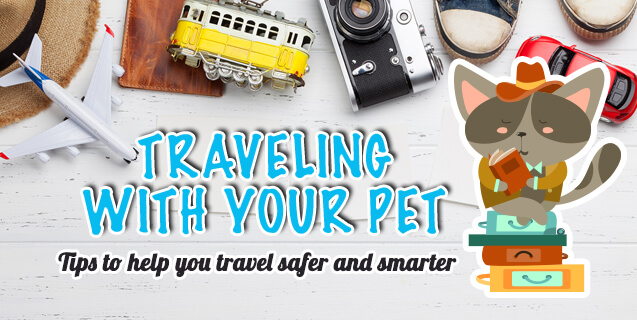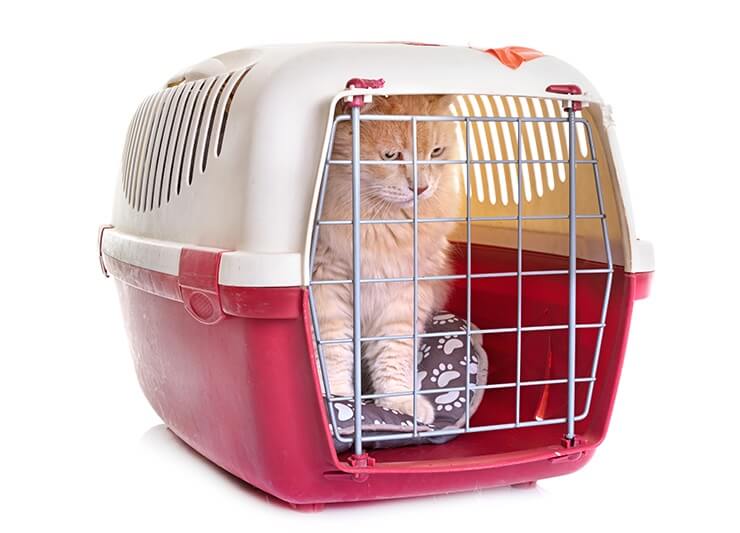
Travel with your pets, whether by plane or car, can be a challenge. We have created a collection of tips to help make your journey as comfortable as possible, for both you and them!
AIR TRAVEL
Flying can be a long and often traumatic experience for you pet. If your pet is small enough to ride under your seat, then at least you are present, aware of their condition and can calm them if need be. For larger animals that must fly in cargo, it’s best to avoid air travel if it is at all feasible. If there are no alternatives and you must bring your pet along on the flight, there are a few things that can make the experience go as smoothly as possible.
Check Your Airline’s Pet Policies
Each airline’s rules and restrictions vary from one another. Make sure that your specific needs are compliant with the airline that you are flying. For instance, some airlines restrict certain types of breeds from flying in cargo, or have different allowable carry-on sizes for pets and carriers.
 Book A Direct Flight
Book A Direct Flight
If possible, book a direct flight vs. one with layovers. The less time that your pet has to spend in their crate or carrier, the better. Also, if you pet is traveling in the cargo hold, layovers sometimes involve longer times on the tarmac which can lead to more stress and depending on weather conditions, more exposure to extreme heat or cold.
Health Check
Prior to your trip, schedule an appointment with your pet’s veterinarian for a checkup. You want to be sure that your pet is healthy enough to travel, and is not at risk for passing a disease to other animals or to people. Some states and foreign countries require a recently issued health certificate in order to allow your pet to travel. Your vet can issue your pet a health certificate verifying that they are in good health, disease free and that the necessary vaccinations are up to date.
If you are traveling outside of the continental United States it would be best to contact the appropriate foreign office of the country you are traveling to for more information on any additional health care requirements may be required so you can plan for them.
Trip Rehearsal
If your pet is not accustomed to leaving the house for long periods of time, or being in a crate or carrier then it might be a good idea to get them acclimated to the situation. Start with shorter times, say in a drive in your car, and gradually increase the duration spent outside of the house until they can comfortably be away for a longer stretch of time.
Communicate
If you are traveling with a pet in the cargo hold be sure to inform airline employees at the gate and the in-flight crew that you have a pet on board. They will be able to help answer any questions or concerns you have. In the event of an extended plane delay, you can request that airline personnel check on your pet or get a status update. Depending on the conditions and length of the delay, your pet may need to be taken out of the cargo hold and off the plane.
CHOOSING THE RIGHT CRATE OR CARRIER
 The crate should be appropriately sized to your pet’s dimensions. They should be able to sit up, stand and turn around inside the crate comfortably.
The crate should be appropriately sized to your pet’s dimensions. They should be able to sit up, stand and turn around inside the crate comfortably.
You must use a shipping crate approved by the USDA in order to fly with your pet either as cargo or checked baggage. Non-compliant kennels can be rejected at check-in causing a host of logistic problems including missing your flight. The USDA regulations are designed to meet safety and welfare standards for both your pet and any human handlers. The International Air Transport Association (IATA) also has a detailed document that looks at container requirements.
Preparing your pet’s crate or carrier
Line the crate or carrier, with soft, dry material or bedding. Using your pet’s usual bedding, blankets, etc. will be more comforting than new off-the-shelf items that will smell unfamiliar. The lining should be absorbent enough to soak up any accidents that may occur. Freeze a small container of water ahead of time. You can pack it in the crate without worrying about it spilling and will melt over time. Any food you put in should be dry and in a separate dish. Do not lock the crate. In case of an emergency, airline personnel should be able to open it.
Be sure to include a leash, collar and ID tags inside the kennel in the event that airline personnel need to remove your pet from the kennel for any reason.
TAKING A ROAD TRIP
Here are a few tips on how best to prepare for an extended drive by car with your pet.
Preparing for the drive
If your pet is not accustomed to leaving the house for long periods of time, especially in a carrier or crate, then it might be a good idea to get them gradually more acclimated to being confined in the car away from home and on the go for extended periods of time. Start with shorter times, a quick drive in your car, and gradually increase the duration spent with each trip.
Carriers
Depending on the length of your trip, you may want to secure your pet in a well-ventilated and cool carrier. Leaving your pet free to roam around the vehicle can lead to additional risks such as them interfering with your driving or taking your attention away from the road at an inopportune moment. If you do decide not to crate your pet, then make sure that they are contained in the rear of the vehicle and don’t allow your pet to ride with their heads or bodies hanging outside of the window.
What to bring?
Plan ahead and make a list of necessities for the road:
- Make sure that your pet is chipped and/or has a collar with ID tags. Long distance travel can be traumatic for some animals and if they are in unfamiliar territory, they may get spooked and exercise the “flight” part of the Fight or Flight response. Being able to identify them in this type of event is paramount.
- Be sure to bring enough food appropriate for the length of your trip.
- Plenty of water. Bottle a large enough quantity from the source your pet normally drinks from. Giving them water from an unfamiliar source along the way can sometimes cause stomach upset.
- A sturdy bowl, a leash to walk your pet when you are making a stop, waste removal bags, Shampoo or grooming supplies.
- Be sure to pack any medications that your pet is currently required to take.
- Pack a familiar blanket or toy in order to add comfort and a sense of home.
When stopping for an extended time
Do not leave your animal alone in a parked vehicle. Even in the shade, a car can be 10 to 20 degrees hotter than outdoors, and cracking the window has almost no effect. Plus a common mistake is parking in the shade and thinking that the shade will be constant. We all know the sun’s position changes through out the day. Once the sun shifts and the location is no longer shaded, the care can heat up incredibly quickly in direct sunlight. Conversely, In cold weather, the temperature inside the vehicle left unattended can plunge rapidly to dangerous levels.

